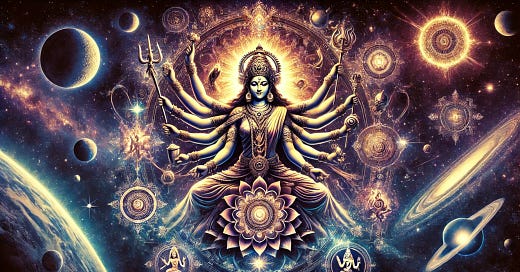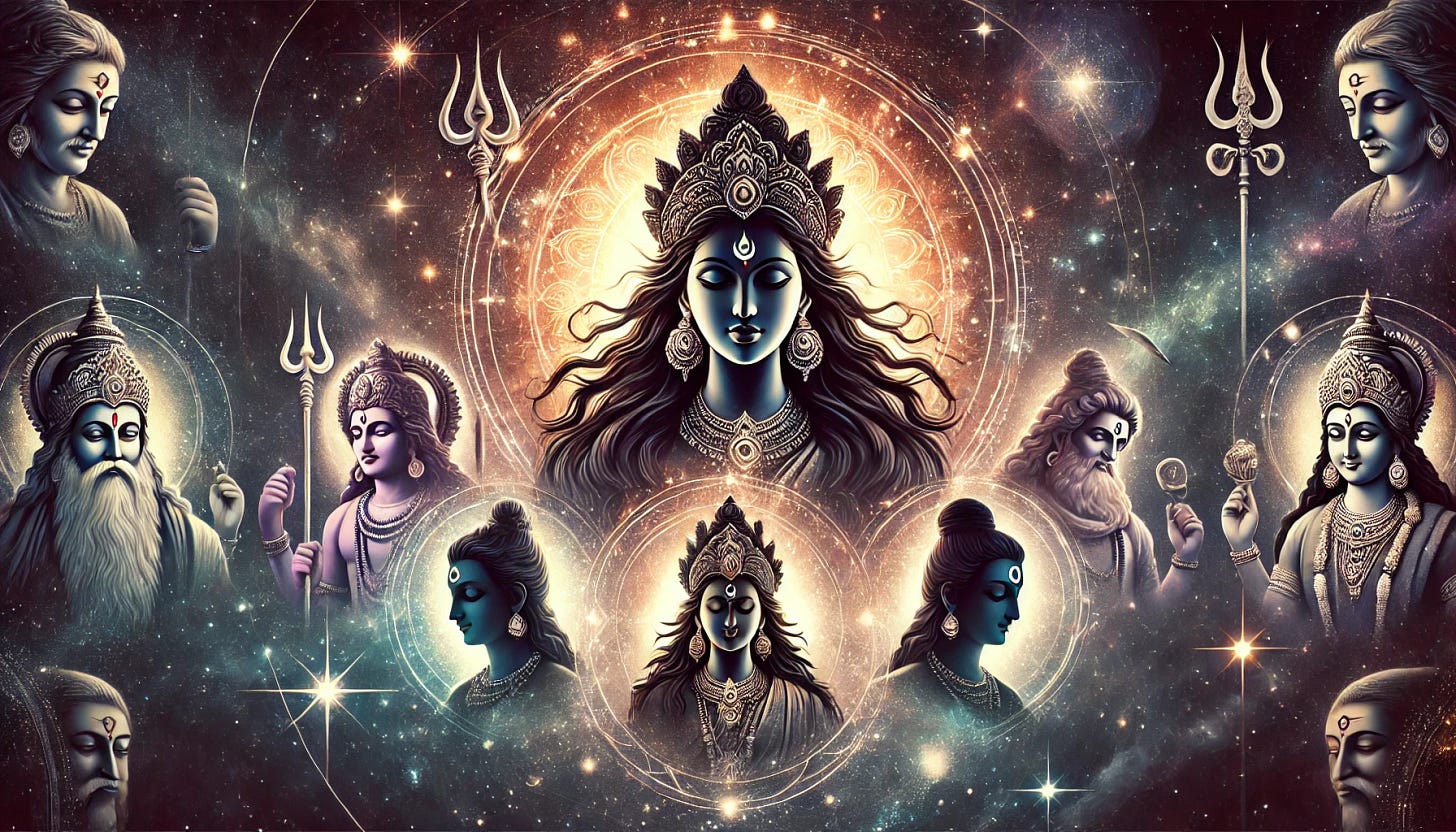Goddess Durga as the Adi Shakti and the Hindu Trinity: Do They Hold the Key to Understanding Modern Physics?
Goddess Durga as the Adi Shakti and the Trinity of Brahma, Vishnu, and Mahesh (Shiva): Using Hindu Metaphysics to Explore the Big Bang and Modern Physics.
Author's Note: Last evening, I was feeling a little unwell and had a rather disturbed night's sleep. However, I woke up this morning feeling refreshed and rejuvenated, with these thoughts crystallized in my mind. Though I had previously reflected on this subject, it was definitely not in my active thought process last evening. Yet, the following conceptual framework emerged with remarkable clarity, like a crystal, as if it had been waiting to take shape. I am sharing it with you without any delay, hoping it resonates as profoundly with you as it did with me.
A Hindu Metaphysical Interpretation of the Big Bang and Modern Physics
The ancient Hindu concept of Adi Shakti—the primordial energy—provides a compelling lens to understand the creation and sustenance of the universe. Within the mythological framework, Goddess Durga embodies this Shakti as the creative, sustaining, and destructive force. When juxtaposed with modern physics, particularly the Big Bang theory of the universe's origin, Adi Shakti can be envisioned as the cosmic egg or singularity, the primal source of all matter, energy, space, and time.
Here, we explore a hypothesis that interprets Hindu metaphysics through the universally accepted principles of modern physics, demonstrating how the profound truths of ancient Indian spiritual texts and traditions align with, and indeed predate, the scientific theories that emerged much later. While some quasi-spiritual, commercialized ‘gurus’ and half-baked physicists—whom I shall refrain from naming—have attempted to draw analogies in this domain, I humbly submit that our framework is distinct, at least in its presentation, if not entirely in its fundamental paradigm.
The Cosmic Egg and the Big Bang
In the ancient Hindu cosmology, creation begins with the Brahmanda (cosmic egg), an infinite singularity of energy that explodes to create the universe. This is strikingly similar to the Big Bang theory, which posits that the universe originated from a single, infinitely dense—but infinitesimally small— point of mass-energy around 13.8 billion years ago.
Adi Shakti as the Singularity: Goddess Durga, as Adi Shakti, represents this primal, undifferentiated energy. Before creation, she exists in a latent form, containing the potential for all matter, energy and forces. The moment she "awakens" and manifests, the Big Bang occurs, birthing the universe and the fundamental and immutable laws of physics—indeed of the entire existence.
The Three Cosmic Forces as Manifestations of the Three Hindu Trinity (Deities)
After the universe's birth, it is governed by three fundamental forces, which find their uncanny parallels in Hindu metaphysical thought:
1. Gravitational Force as Lord Brahma
Physics: Gravity, the weakest of all forces, governs the large-scale structure and dynamics of the universe. It holds galaxies, stars, and planets together, enabling cosmic order. Though omnipresent and essential, gravity is subtle and imperceptible in daily life compared to stronger forces like electromagnetism.
Hindu Metaphysics: Lord Brahma, the creator, manifests through this all-pervasive force. Just as gravity enables the formation of celestial structures and keeps them in orbit, Brahma initiates creation and the underlying cosmic order. However, Brahma is worshipped less frequently in Hinduism, symbolizing humanity’s tendency to overlook the subtle but foundational forces of existence. The stories surrounding Lord Brahma, such as those at Pushkar, are rich with allegorical significance, hinting at his indispensable yet understated role in the cosmic design.
2. Electromagnetic Force as Lord Vishnu
Physics: The electromagnetic force governs interactions between charged particles, enabling the formation of atoms and molecules—the building blocks of matter. This force manifests in phenomena like light and magnetism and is harnessed in technologies such as electricity generation, electromagnetic machines, and telecommunications. For example, current-carrying conductors generate magnetic fields, while conductors moving through magnetic fields induce electric currents, powering electric generators and motors. Beyond its role in sustaining life through processes like photosynthesis, the electromagnetic force is indispensable to modern civilization, which would be unimaginable without its countless applications.
Hindu Metaphysics: In Hindu belief, Lord Vishnu, the preserver, embodies the principle of sustenance and balance, closely aligning with the electromagnetic force. Just as Lord Vishnu sustains creation, electromagnetic interactions uphold the structure and functioning of matter. Lord Vishnu’s various incarnations (avatars), including Lord Ram and Lord Krishna, throughout the ages symbolize and personify the different forms of celestial or cosmic energy that have emerged as pivotal sources of sustenance and preservation for human civilization—be it fire, water, wind, or electricity in the modern era. His prominence in Hindu worship reflects humanity's reverence for this perceivable and essential force, which continues to sustain life and civilization in profound ways.
3. Nuclear Force as Lord Shiva
Physics: The nuclear force, which binds protons and neutrons within atomic nuclei, is the strongest of the three fundamental forces but operates only at microscopic scales. This immense force holds the potential for tremendous energy release, as seen in nuclear reactions, which can be both creative (such as fusion powering stars) and destructive (atomic explosions).
Controlled nuclear fission, achieved in reactors, already provides a virtually inexhaustible source of energy, offering a stable and efficient means of power generation. However, we continue to strive for controlled nuclear fusion, the process that powers the sun. Fusion, where hydrogen nuclei combine to form the inert gas helium, generates enormous energy with water as the only by-product, making it the cleanest and most sustainable energy source imaginable. Successfully harnessing fusion would enable us to create a "mini-sun" in our laboratories, revolutionizing energy production and paving the way for a cleaner, more energy-abundant future.
Hindu Metaphysics: Lord Shiva as the Cosmic Cause: Nuclear Energy as His Manifestation
In Hindu metaphysics, Lord Shiva, the destroyer and transformer, is the ultimate cosmic cause, and nuclear energy is but one of his many manifestations. Lord Shiva embodies the raw, unbounded power necessary to dissolve chaos and usher in a new cycle of creation. His Tandava, the celestial dance of destruction, is not merely symbolic but a profound expression of the energy required to obliterate the evil forces that threaten the survival of civilization. Nuclear energy, with its unparalleled destructive and regenerative potential, is just a tangible manifestation of this divine power.
When Shiva performs the Tandava, he wields cosmic energy with such intensity that it becomes nearly uncontrollable, mirroring the immense release of energy in nuclear reactions. This energy, though capable of unimaginable destruction, also holds the seeds of renewal, symbolizing Lord Shiva’s role as the force that paves the way for creation through destruction. Yet, this raw power requires balance, which is where Shakti/Parvati, his divine consort, becomes indispensable. As the embodiment of harmony and wisdom, she intervenes to channel Lord Shiva’s destructive force into a creative, regenerative one, ensuring that his power is directed toward preserving cosmic equilibrium.
In this framework, nuclear energy is not the cause but a manifestation of Shiva’s cosmic role. The immense power of nuclear fission and fusion, whether used for destruction or as a life-sustaining force, echoes Shiva’s divine dance. Just as Shakti tempers Lord Shiva’s Tandava, humanity must wisely channel nuclear energy, ensuring it becomes a tool for progress rather than the annihilation of civilization. This perspective highlights the profound connection between divine forces and the energies present in the universe, reflecting the cosmic principles embodied by Shiva and Shakti.
The Unending Cycle of Creation, Sustenance, and Destruction
In the ancient Hindu cosmology, creation (Brahma), sustenance or preservation (Vishnu), and destruction (Shiva) are not linear but cyclical, reflecting the universe's eternal cosmic rhythm. Modern physics also acknowledges the universe's cyclic possibilities through theories of expansion, contraction, and rebirth, even as it talks about the expanding universe.
When the universe eventually collapses or transitions into a new state (analogous to Shiva’s destruction), the energy released feeds into the primordial Shakti, setting the stage for another cosmic cycle. Thus, Goddess Durga, as Adi Shakti, reemerges as an essential ingredient if not the sole source of a new creation, billions of years hence.
Shakti and Modern Physics
The metaphorical connection between Adi Shakti and the laws of physics reveals profound insights:
Energy as the Essence of Existence: Modern physics establishes that energy is neither created nor destroyed, aligning with the Hindu view of Shakti as the eternal force behind all creation.
Conservation of Energy: The transformations between potential and kinetic energy, much like the cyclic forms of Durga (creation, preservation, destruction), reflect the unending dynamism of the cosmos.
Singularity to Multiplicity: Just as Adi Shakti manifests in countless forms to sustain the universe, the Big Bang singularity expands into the complex diversity of the cosmos.
Destruction as Renewal
The nuclear force (Shiva) provides a compelling example of how destruction paves the way for renewal. In nuclear reactions, such as in stars, immense energy is released, enabling the creation of heavier elements necessary for life. Similarly, Lord Shiva’s dance of destruction symbolizes the end of one cycle and the beginning of another. When nuclear destruction occurs (e.g., supernovae), the released energy and matter ultimately contribute to the rebirth of celestial bodies—a cosmic manifestation of Shakti.
Conclusion: Hindu Metaphysics as Proto-Physics
The ancient Hindu understanding of the universe, as personified by Durga and the trinity of Brahma, Vishnu, and Shiva, provides a symbolic framework for interpreting the forces that modern physics has only recently discovered and begun to fully appreciate (though still not entirely understood). Adi Shakti’s eternal presence as the cosmic energy aligns seamlessly with the scientific view of energy as the fundamental essence of existence.
Through this lens, ancient Hindu metaphysics is not merely mythology but a profound philosophical interpretation of the universe’s structure and function—a precursor to the principles of modern physics. The resurgence of Shakti in every cosmic cycle serves as a powerful reminder of the eternal interplay between energy, matter, and consciousness, grounding humanity in the timeless dance of creation and destruction. We are fortunate to live in an era where cosmic energies and forces continue to ensure the sustenance and preservation of human civilization, even as some of our own petty but thoughtless actions threaten to sow the seeds of our premature destruction.
Epilogue
Four years ago, I posted a YouTube video titled Quantum Physics to Understand ॐ, Atman, Intellect, Mind, Senses & Body Continuum. The subject of that exploration, while related to this discussion, ventures into a higher quantum direction and demands a deeper grasp of the foundational concepts of physics. Unlike the present framework, which seeks to draw connections accessible to a broader audience, that video delves into the nuanced interplay between quantum phenomena and the spiritual dimensions of existence.
For those who find themselves intrigued by these intersections of science, metaphysics, and spirituality, I share this video reference for further exploration. It invites you to delve into profound questions about the nature of consciousness, the self, and the continuum that binds us to the universe—questions that lie at the heart of both ancient wisdom and cutting-edge science.
May like to share with the seekers who, you think, would benefit from this write-up-cum-video.






Compelling reading
So much to comprehend ! Thanks